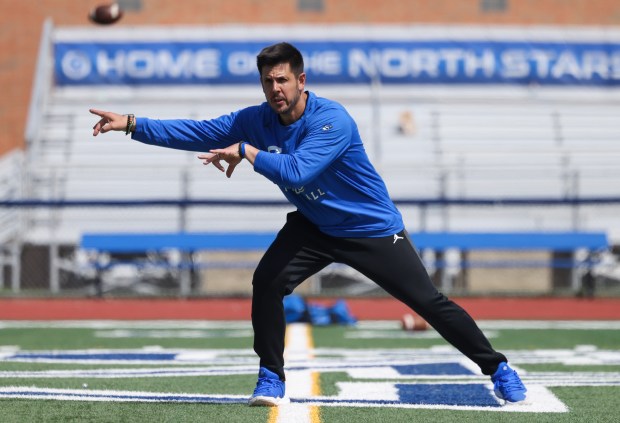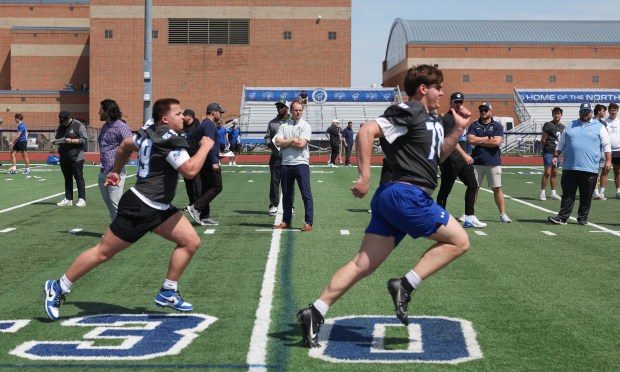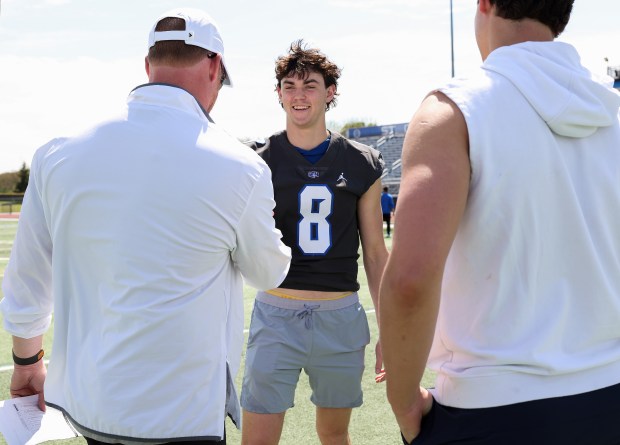Chicago’s western suburbs played host to a sort of “high school crawl” for college football coaches Wednesday, with talent evaluators shuttling from one DuKane Conference football field to the next in search of recruits.
Conference coaches, led by St. Charles North’s Robert Pomazak, started the eight-school event — called “DuKane Day” — a few years ago in an effort to get more eyes on their players amid an increasingly challenging high school recruiting scene.
Coaches from more than 60 colleges at all levels attended to see players work out, chat with them and obtain their information from high school coaches. Pomazak said the day, which was modeled after a similar showcase in Indianapolis, is “a one-stop shop within our conference for them to see upward of 200 to 300 kids, which the coaches find very advantageous because the travel is pretty rigorous.”
Other high schools and conferences around the Chicago area are fielding similar events — or hoping to — as they look for new ways to promote their recruits.
“This allows us to promote our conference, which is important, but also promote every player within our program, not just the blue-chip athlete,” Pomazak said. “Because the majority of kids who go to college to play football are not Division I scholarship athletes.”
The NCAA transfer portal and this year’s uncertainty about Division I roster limits have changed the recruiting game for high school athletes — and the coaches who try to set them on the best college path.
The Football Bowl Subdivision saw 2,902 players transfer to new schools last year through July 2024, and 1,395 Football Championship Subdivision players transferred in that time, according to NCAA records. The biggest programs’ recruiting attention — and offers of roster spots — often is swayed toward transfers now.
Anecdotally, area high school coaches and their athletes are feeling that shift in terms of the volume of coaches calling — and the level of the programs interested.
Naperville North coach Sean Drendel said two years ago he had 75 colleges visit the school as of May 1. Last year that number was 37. This year it was six.
Instances of regional recruiters checking into high schools each year have decreased, Drendel said, as some programs focus on the portal or shift to positional recruiting.
Glenbard South coach Ryan Crissey said his text conversations with other high school coaches about the number of college recruiters coming by their schools have changed.
It was once: “This week was kind of crazy. We had 13, 14 schools.”
Now it’s: “We had two. We had four.”
“When you look at things from a Division I standpoint, whether it’s the FBS or the FCS, the high school kids for the most part seem to be the afterthought,” Crissey said. “But I understand why. I mean, if I’m the head coach — it doesn’t matter if I’m at Illinois State or if I’m at Illinois — if I can get a 20-year-old who’s played two years in college football compared to an 18-year-old who hasn’t, I’m probably going to take the chance at the transfer kid.”

In the new climate, high school coaches try to find multiple avenues to get their players noticed. That can include utilizing personal connections, reaching out to recruiting services and media analysts — and showcases such as DuKane Day. It’s “a full-time job unto itself,” Pomazak said of helping his players get recruited.
A week before Pomazak’s event, Crissey and Drendel hosted their own version, called “Western Suburbs College Football Evaluation Day.”
The pair had conversations for a couple of years about how to help their athletes get recruited. They wanted to help players who couldn’t afford the prohibitive costs of multiple third-party showcases or college camps, where it’s often hard for non-elite players to stand out anyway. They saw the number of classes some athletes had to miss to meet with colleges. And they wanted to collaborate with other coaches to bring in more college recruiters to see their players.
So last year they started their showcase, a two-day event with 13 high schools and more than 200 players. They spoke with college coaches to tailor the schedule and put the players through agility workouts, positional drills and unpadded competition periods.
Sixty-seven coaches from multiple college levels attended this year’s event, though attendance by FBS programs was limited, Crissey said, based on each school’s interpretation of rules by its compliance officer. The DuKane schools hold their event on each school’s individual field to ensure FBS programs can attend without being wary of NCAA violations.
Crissey and Drendel said they’re working on a proposal to help their event be open to more FBS schools. But Drendel said their event is especially useful for smaller schools anyway.
“The big schools, they have an endless budget, so it doesn’t matter to them,” Drendel said. “But if you’re at Western Illinois or Eastern Illinois, your budget is not as big, so you need to see as many kids in a short amount of time as you can.
“Generally you can only hit so many schools a day. So if we can put six to eight of them in an area for a two-hour period, they can kill a lot of birds with a lot of stones. And we can go back to our parents and say, ‘We had them evaluated.’”
The broad range of college programs at the events is important at a time when multiple high school coaches said they’ve had to adjust their athletes’ expectations for the level of football they can play to start their college careers.
Jacobs coach Brian Zimmerman, who hopes the Fox Valley Conference can start its own showcase next year, said he has seen some “mind-boggling” recruiting droughts for players he thought deserved better.
“I had a couple of kids this year that in my opinion would have been at least Division II or FCS kids that I couldn’t get a sniff from coaches,” Zimmerman said. “If you’re a tweener kid who might not be a three-, four-, five-star (recruit), you might have to look to start at a lower level.”

Zimmerman and other coaches are advising players that the path to playing football in college might look different now. One of Zimmerman’s former players, tight end Nick True, is transferring from Illinois to a smaller school because he wants more playing time. He valued his time as a walk-on at Illinois but said if he were in high school now, he might have made a different decision “if I knew about how crazy this portal thing is.”
The lower-level programs have embraced selling the new path of the high school player, playing up the developmental aspect that might not be as likely anymore at FBS programs if young players can’t get on the field, Crissey and Drendel said.
And they’re offering another promise.
“There are plenty of colleges, all divisions except for FBS, that will come in and tell our higher-level kids, ‘Come to us for two years, and we will help you transfer,’” Crissey said. “Never in my life would we have heard that three, four years ago.”
As Pomazak said, “the ecosystem of recruiting has changed 180 degrees.” And high school showcases are one way coaches can help their players adapt to the changing times in college sports.



